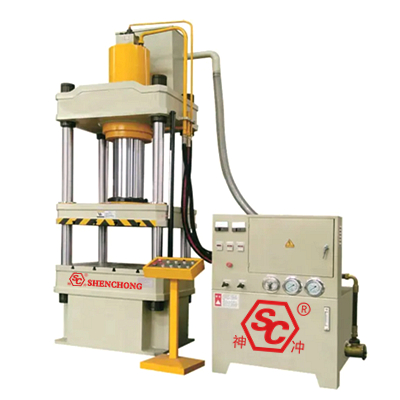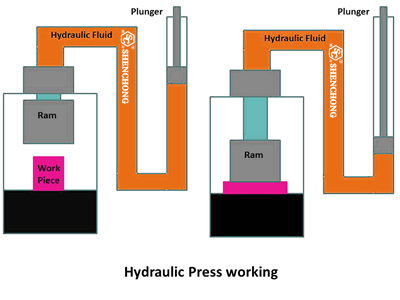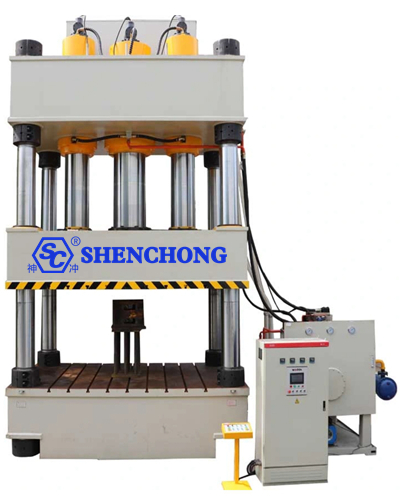
The new servo-driven hydraulic press (referred to as servo hydraulic press) is an energy-saving and efficient hydraulic press that uses a servo motor to drive the main transmission oil pump, reduce the control valve circuit, and control the hydraulic press slider. Suitable for stamping, die forging, press fitting, straightening and other processes.

Compared with ordinary hydraulic presses, servo hydraulic presses do not include proportional servo valves or proportional pump links in the overall system control. Servo-driven hydraulic presses have the advantages of energy saving, low noise, small temperature rise, good flexibility, high efficiency, and easy maintenance, and can replace existing servo hydraulic presses. Most ordinary hydraulic presses have broad market prospects. Compared with traditional hydraulic presses, the energy saving effect is significant. Depending on the processing technology and production rhythm, servo-driven hydraulic presses can save 30% to 70% of electricity compared with traditional hydraulic presses.

Servo-driven hydraulic oil pumps generally use internal gear pumps or high-performance vane pumps. Traditional hydraulic machines generally use axial piston pumps. Under the same flow and pressure, the noise of internal gear pumps or vane pumps is 5dB lower than that of axial piston pumps. ~10dB. The motor of the servo-driven hydraulic press operates at rated speed during pressing and return, and its emission noise is 5dB to 10dB lower than that of traditional hydraulic presses.
When the slider drops rapidly and the slider is stationary, the servo motor speed is 0, so the servo-driven hydraulic press has basically no noise emissions. During the pressure-holding stage, due to the low motor speed, the noise of a servo-driven hydraulic press is generally less than 70dB, while the noise of a traditional hydraulic press is 83dB~90dB. After testing and calculation, under normal working conditions, the noise produced by 10 servo hydraulic presses is lower than that produced by an ordinary hydraulic press of the same specification.
Since the hydraulic system of the servo-driven hydraulic machine has no overflow and heat, and there is no flow when the slider is stationary, there is no hydraulic resistance and heat. The calorific value of the hydraulic system is generally 10% to 30% of that of a traditional hydraulic machine. Due to the low heat generated by the system, most servo-driven hydraulic machines do not need a hydraulic oil cooling system, and some that generate large amounts of heat can be equipped with a low-power cooling system.
Since the pump rotates at zero speed most of the time and generates little heat, the oil tank of a servo-controlled hydraulic machine can be smaller than that of a traditional hydraulic machine, and the oil change time can also be extended. Therefore, the hydraulic oil consumed by a servo-driven hydraulic machine is generally only about 50% of that of a traditional hydraulic machine.

The pressure, speed, and position of the servo-driven hydraulic press are fully closed-loop digitally controlled, with high automation and good precision. In addition, its pressure and speed are programmable and controllable to meet various process needs, and it can also achieve remote automatic control.
Through appropriate acceleration and deceleration control and energy optimization, the speed of the servo-controlled hydraulic press can be greatly increased, and the working rhythm is several times higher than that of the traditional hydraulic press, reaching 10/min~15/min.
Since the proportional servo hydraulic valve, speed regulating circuit and pressure regulating circuit in the hydraulic system are eliminated, the hydraulic system is greatly simplified. The cleanliness requirements for hydraulic oil are much lower than those of hydraulic proportional servo systems, which reduces the impact of hydraulic oil contamination on the system.
Although the traditional hydraulic press system adopts the energy-saving solution of constant power variable pump, when the machine tool is in the fast-moving, pressure-maintaining, and robot loading and unloading states, the three-phase asynchronous motor will still drive the oil pump to work, and the output oil at this time will pass through the hydraulic system. The system overflows back to the fuel tank, causing great waste of energy. At the same time, circulation overflow can easily cause the oil temperature to rise.
Pump-controlled electro-hydraulic servo technology utilizes the high-speed response of the servo motor to achieve instant oil supply. It can also achieve different pressures and flows required in each process. By detecting the pressure and flow signals from the hydraulic press control system in real time, it can adjust each step in a timely manner. The servo motor speed required for operating conditions allows the pump output flow and pressure to maximize the system's needs, while in the non-action state, the servo motor runs at a low speed.
Generally speaking, the energy saving effect can reach 20%-70% compared with before the transformation. In addition, the noise and oil temperature are also significantly reduced. At the same time, because of the use of servo drives, the intelligent transformation and upgrading of the hydraulic press machine can be easily carried out. It is certain that the servoization of hydraulic presses is the future development direction. Servo energy-saving transformation of hydraulic presses can also achieve huge efficiency. I believe that this cost-effective pump-controlled electro-hydraulic servo system will be recognized by more customers and will surely promote changes in the entire industry.
The energy-saving hydraulic station dedicated to servo hydraulic machines machine adopts "pump control servo" technology, which achieves precise control of flow and pressure through precise control of the pump's torque and speed. It is mainly composed of electro-hydraulic servo driver, three-phase AC permanent magnet synchronous motor, high-performance special servo pump, pressure sensor and other parts. Since the output flow of the oil pump is proportional to the motor's speed, the pressure in the oil circuit is proportional to the motor's output torque.
Through double closed-loop control of system pressure and flow, vector control + magnetic field weakening control + special PID control algorithm are used to complete precise control of the pump's torque and speed, achieve accurate supply of flow and pressure according to actual needs, and eliminate high-pressure throttling energy loss, overcoming the problem of the oil temperature rising too fast caused by high-pressure throttling in the traditional "valve-controlled servo" system, achieving the effect of energy saving and power saving, while reducing the system oil temperature, with a maximum energy saving rate of 70% and an average energy saving rate of 30%.
Click this to know Hybrid Servo Press Brake Machines